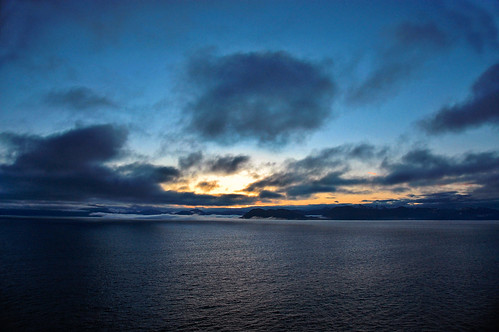 Ocean acidification is an imminent and potentially disruptive threat to Alaska's coastal waters, but with a concerted, well-coordinated effort, the state's fisheries will remain sustainable, says federal fisheries scientist Jeremy Mathis.
Ocean acidification is an imminent and potentially disruptive threat to Alaska's coastal waters, but with a concerted, well-coordinated effort, the state's fisheries will remain sustainable, says federal fisheries scientist Jeremy Mathis.The first of two buoys for ocean acidification network are to be deployed in February, to serve as an early warning system and economic tool for Alaska's fisheries. The project is funded by a $2.7 million allocation from the Alaska Legislation, and information gleaned from the buoys and sent to the Pacific Marine Environmental Lab for the National Oceanic and Atmospheric Administration will be posted online on the Alaska Ocean Observing System website, www.aoos.org
"The sky is not falling," Mathis told several hundred people attending the Alaska Marine Science Symposium in Anchorage Jan. 21, "but we do know that there is a major catastrophic event coming if changes are not implemented."
Mathis, who holds a doctorate in marine chemistry from the University of Miami, is on the staff of the Pacific Marine Environmental Lab, and an affiliate professor with the Institute of Marine Science at the University of Alaska Fairbanks. His current research focuses on constraining carbon dioxide fluxes and ocean acidification – related to the uptake of carbon dioxide at the ocean surface- in coastal regions. He delivered a keynote address to the symposium on preparing for the challenges of ocean acidification in Alaska, noting that melting glaciers as well as acidity welling up for deep in oceans, were contributing factors.
Over the past two and a half centuries, but mainly over the past 50 years, the pH of the ocean has been reduced due to the intrusion of anthropogenic carbon dioxide, produced mainly from fossil fuel burning and changes in land use practices, he said.
A pH unit is a measure of acidity, ranging from 0-14. The lower the value, the more acidic the environment. Scientists are concerned about even small changes in pH levels because many organisms are very sensitive to these small chances in acidity. Marine organisms are very sensitive to either direct or indirect change in acidity, which can affect their respiration, calcification (shell building) photosynthesis and reproduction. Studies have shown that a more acidic environment has a dramatic effect on some calcifying species, including oysters, clams, sea urchins, shallow water corals, deep sea corals and calcareous plankton.
Also very sensitive to ocean acidification are pteropods, tiny sea creatures about the size of a small pea, eaten by organisms ranging from tiny krill to whales. Pteropods are a major food source for North Pacific juvenile salmon.
Mathis noted in his presentation that scientists have documented the affects of ocean acidification on pteropods in southern oceans off of Antarctica and are beginning a project this year with UAF to study pteropods in the Gulf of Alaska, to see how they are responding to changes in the pH of waters there.
As ocean acidification continues to increase "we will still have fisheries, if we are willing to eat different fish," he said. But until people can kick the CO2 habit, all we can do is to treat the symptoms of rising CO2 levels, he said.
Source: Cordova Times
Photo courtesy of vl8189 via Flickr (CC BY 2.0)
